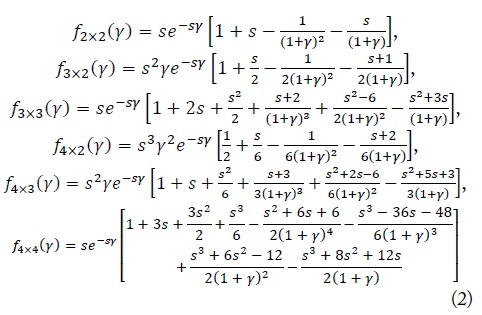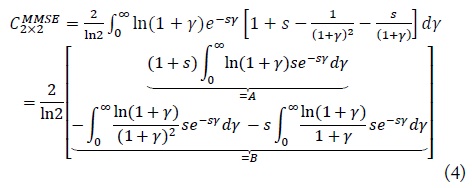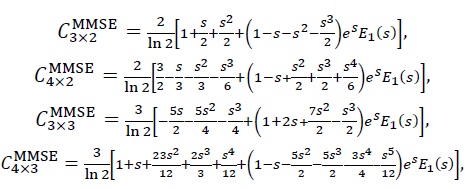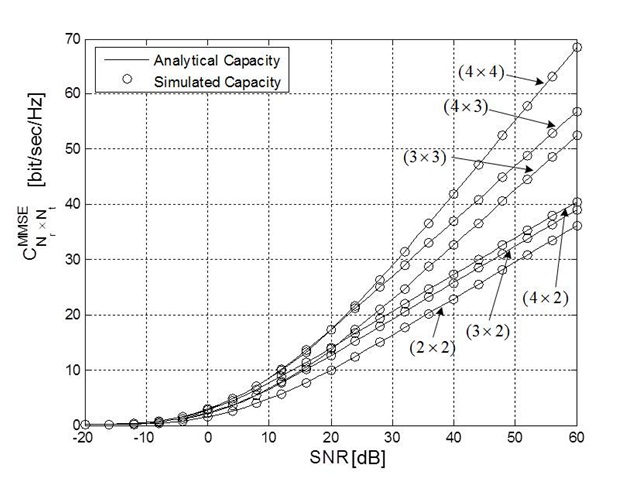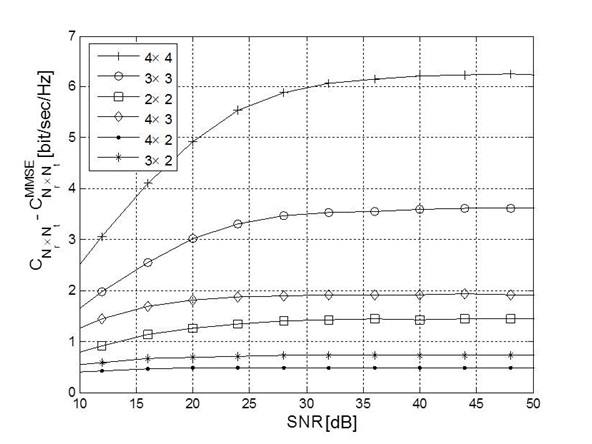



This paper considers the multiple-input multiple-output (MIMO) system with linear minimum mean square error (MMSE) detection under ideal fast fading. For Nt transmit and Nr(≥Nt)receive antennas, we derive the achievable ergodic capacity of MMSE detection exactly. When MMSE detection is considered in a receiver, we introduce a different approach that gives the approximation of a MIMO channel capacity at high signal-to-noise ratio (SNR). The difference between the channel capacity and the achievable capacity of MMSE detection converges to some constant that depends only on the number of antennas. We validate the analytical results by comparing them with Monte Carlo simulated results.
The use of multiple antennas at the transmitter and receiver provides a higher capacity than that of a single antenna system [1]. Multiple-input multiple-output (MIMO) communications have been intensively studied over the last few years and are widely considered as suitable for improving performance of modern wireless communications [2].
Maximum-likelihood (ML) detection gives the maximum receive diversity and has high computational complexity. We can apply linear zero-forcing or minimum mean square error (MMSE) detectors to reduce computational complexity. Unfortunately, linear receivers have a smaller diversity order than that of the ML detector.
In [3], the authors derived the achievable instantaneous capacity of a MMSE detector for a given channel matrix H. However, we have introduced the achievable ergodic capacity for an uncorrelated channel matrix H. In this paper, we investigate the analytical measurement associated with MMSE detection. We use the probability density function (PDF) of signal-tointerference plus noise ratio (SINR) [4] to obtain a precise value for the achievable capacity of the MMSE detector. We also derive the achievable ergodic capacity of the MMSE detector at high SNR. Finally, we confirm for a small number of antennas that the difference between the channel capacity and the achievable capacity of the MMSE detector converges to some constant that depends on the number of transmit and receive antennas.
We consider single-user communications and investigate a point-to-point link, where the transmitter is equipped with
where denotes the received complex vector, is the transmitted vector with the power is an independent and identically distributed (i.i.d) complex Gaussian fading channel matrix with unit variance, and is an additive white Gaussian noise with zero mean and variance
Suppose that the transmitter does not know the channel realization. Minimizing the mean squared error (MSE) between the actually transmitted symbol x
III. ACHIEVABLE CAPACITY OF MMSE RECEIVER
We introduce the PDF of SINR at output of linear MMSE detector to calculate the ergodic capacity. We use it for analytical derivation of the ergodic capacity obtained by the MMSE detector. For a high SNR, we will prove that the difference between the channel capacity and the capacity of the MMSE detector converges to the constant that depends only on
For small
For the uncorrelated MIMO channel, the ergodic capacity achievable by the MMSE detector can be defined as [3]
For example, in
We can easily check the first term in Eq. (4) by [5, 4.337]:
where and
We can obtain the exact ergodic capacity as
In a similar way, can be calculated as the following:
where
We consider an independent and identically distributed Rayleigh fading channel with
At a high SNR regime, the capacity of the MMSE detector for a MIMO system can be approximated as
Up to
where
Note that μ is Euler’s constant. In [6], the authors found the approximation for ergodic channel capacity at high SNR as
The difference between the MIMO channel capacity and the capacity of the MMSE detector converges to some constant as
The Eq. (13) shows that the achievable capacity of the MMSE detector has constant capacity degradation. We will validate the capacity degradation by the simulation results shown in Fig. 2.
In this paper, we have studied the achievable ergodic capacity of a MIMO system with a MMSE detector for a small number of antennas. We have also shown that the difference between the channel capacity and achievable capacity of the MMSE detector converges to some constant at high SNR.

